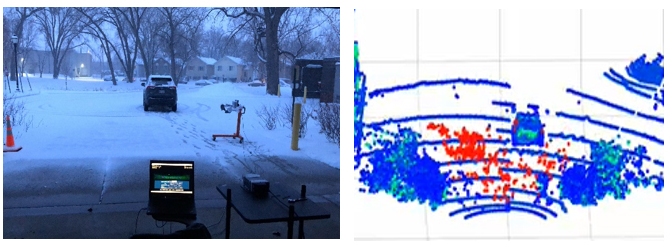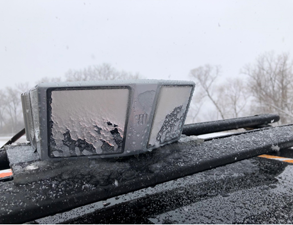Fully automated vehicles may not be market-ready yet, but one day, they expect to provide a variety of benefits like reduced emissions and greater safety and transportation equity. These vehicles and the complex combination of underlying technologies that power them are continually being tested and improved to ensure the vehicles will meet the highest standards of safety and performance.
Recent research provided improvements to automated vehicles’ lidar technology, which has traditionally experienced a loss of accuracy in some adverse weather conditions.
“While more research is still needed, this project shows that technology may one day be able to detect obstacles in a variety of adverse conditions better than the naked eye is able to,” said Robert Chaucierre, transportation program specialist, MnDOT Office of Traffic Safety.
Lidar helps autonomous vehicles sense and navigate their surroundings. Ituses mounted lasers to continuously scan and collect data that’s then processed to create 3D maps of the vicinity in real time. While lidar works well on clear days, it can be unreliable in foggy, rainy or snowy weather as the particles in the air reflect or reduce the lasers’ signals. Currently, automated vehicles that use lidar under such environmental conditions can measure data inaccurately and misinterpret or fail to detect objects around them—a potential hazard for all road users.
To identify enhancements that will help automated vehicle technology become better and safer for everyone, MnDOT engaged a team of researchers to test lidar’s capabilities in adverse weather and recommend solutions to help automated vehicles succeed in any Minnesota environment.
What Was Our Goal?
This research sought to capitalize on Minnesota’s winter climate to advance the collective knowledge regarding automated vehicle technology. Through a variety of simulations and on-road tests, MnDOT aimed to better understand lidar’s challenges and identify improvements that will increase and refine the technology’s accuracy in all types of weather.
What Did We Do?
Researchers began by reviewing previous studies and published literature related to particles’ effects on lidar signals. The lack of documentation on the topic validated the need for this study and proved the value of this line of inquiry.
To ensure results manufacturers could use, the researchers collaborated with leading companies to combine experience and cutting-edge equipment for maximum benefit. The research team assessed state-of-the-art lidar systems and data processing software through a series of stationary and mobile tests under controlled and actual conditions.
Since fog can be difficult to test in nature, the research team created a simulated environment by installing a lidar system in the center of a fog chamber. By directing the technology’s visibility sensor toward a stationary target object and repeatedly generating plumes of moisture at precise intervals, the team was able to measure the lidar’s signal and gather valuable insight about the technology’s performance in dense fog.
“We’ve found that lidar technology can ‘see’ better and further in fog than we can see with a camera system or with our own eyes. Because snow particles are more substantial, we don’t get that same benefit, but technological improvements show promise,” said William Northrop, associate professor and director of undergraduate studies, University of Minnesota Department of Mechanical Engineering.
For realistic on-road tests of lidar’s performance in snowy conditions, a system was mounted to the roof of a vehicle. While the vehicle was parked, the researchers evaluated the lidar’s ability to measure objects in an open outdoor area. Team members also evaluated the vehicle in motion in moderate snow and during a snowstorm. Traveling over highways and local roads in these conditions allowed for a realistic assessment of the system’s stability, speed and precision in detecting a variety of objects and pavement markings.
What Did We Learn?
This research produced a number of groundbreaking results. Data from the fog chamber tests showed that lidar is able to detect objects better and from a greater distance in dense fog than humans can on their own. Snow, however, provided more challenges. Since snow particles are typically larger than fog particles, the lidar’s lasers were more reflected during the stationary and mobile vehicle experiments.
To address this issue, the researchers developed and tested a mathematical snow particle filter to help the system recognize and eliminate snow from its collected data. If such a filter is adopted, manufacturers will be able to improve the accuracy of automated vehicles in snowy environments. Additionally, researchers recommended hardware design changes after ice accumulation blocked the lidar’s sensor.
What’s Next?
As lidar is a critical but relatively new component of automated vehicle technology, this project delivered much-needed information. While more research in this and other areas relating to automated vehicles still needs to be done—including similar experiments on the effects of nonwater particles like dust or haze on lidar’s capabilities—this project successfully accomplished its goals of accelerating the current understanding of automated driving technology and progressing the state of practice.
The coordination between public and private industry leaders also proved valuable, providing actionable solutions that can be readily applied to improve the performance and accuracy of lidar systems in realistic weather conditions.



Interesting report. So automated vehicles should focus more on the control for different types of weather.